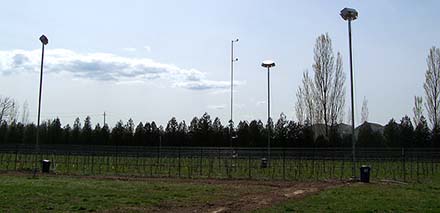Grapevine Frost Protection Technology Tested
Vineland Innovation Centre and Raytheon collaborate on microwave tech in Ontario

Tempwave microwave energy is transmitted from towers approximately 25 feet tall located in vineyards or orchards. The low-powered radio waves that are emitted are tuned specifically to water molecules, causing them to vibrate and heat up just enough to keep them from freezing, similar to a microwave oven. The energy is delivered directly to the crop without heating the intervening air. As temperatures drop to a critical point, the unit activates to change the energy balance and slow cooling to prevent freeze damage.
While preventing damage from frost is an important use for Tempwave, a major use may be in winter, when temperatures have dropped to the point where vines will suffer major damage. One purpose of the testing program now getting started is to determine the low temperatures at which Tempwave will be effective. Other factors to be evaluated will be the health and vigor of the vine and bud hardiness. Scientists at the Ontario Ministry of Agriculture, Food and Rural Affairs at Vineland Station will be cooperating on the project.
Questions about safety are often asked. The main effect of radio frequency electromagnetic fields on humans is the heating of body tissues. Exposure standards for radiofrequency fields and microwaves have been established to prevent adverse health effects that could be caused by localized or whole-body heating. Scientists on the project say that human safety is ensured by compliance with Health Canada’s limits on human exposure. Tempwave also must be in compliance with Canadian standards for radio-frequency equipment set by Industry Canada.
Dr. Jim Brandle, CEO of the Vineland Research and Innovation Centre, sees Tempwave technology as adding to the arsenal of wind machines, heaters, sprinklers and covers now available to manage frost and freezing threats. In comparing Tempwave to wind machines, he looks at the new technology as being able to work under a broader range of conditions, as having greater flexibility in covering up to an acre at a time, and without noise being a factor. The Tempwave tower will be comparable in price to a wind machine.
The agreement between the Centre and Raytheon, which is headquartered in Waltham, Mass., is a co-development/co-marketing partnership in which each party contributes its expertise to test and market the system worldwide. “This new technology will save crops,” Brandle says. “Our partnership with Raytheon is a new chapter in Vineland’s on-going research and innovation to protect Canada’s food supply.”
SHARE »
CURRENT NEWS INDEX »